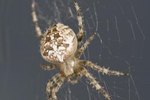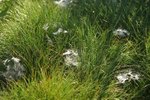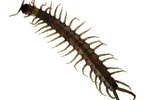
Despite there being more than 2,500 species worldwide in some 20 families, centipedes aren't greatly diverse. They all share common characteristics, including being predatory, terrestrial creatures, most of which require moist habitats. One species is common indoors, but several others may be found in damp basements or cellars. Outdoors, centipedes often take refuge in the damp ground underneath rocks or under bark or fallen trees.
Characteristics
Centipedes have long, segmented flat bodies with a pair of appendages on each segment, except for the first segment behind the head and last two. Every pair of appendages is used as walking legs except those on the head; these appendages are the centipedes' large, venomous fangs used to subdue prey. Centipedes have antennae on their heads and many also have modified appendages used as antennae on their rears. Most centipedes are small, but some exceed 10 inches.
House Centipede
Found throughout North America and many other temperate regions, the house centipede is among the most frequently encountered of all centipedes. These quick-moving, alien-looking creatures are the only centipedes that can breed indoors and as such are the most commonly found inside structures. Reaching approximately 1 1/2 inches long, house centipedes are moderately large. These house-dwellers often move in the direction of humans, although not to attack. It's believed that house centipedes charge toward people because they see a large object they think they can hide under. According to C.L. Marlatt, a turn-of-the-century entomologist for the U.S. Department of Agriculture, it was commonly thought that house centipedes ran for "safety" beneath women's dresses.
Scolopendromorpha
The order Scolopendromorpha contains several centipedes common in the United States, as well as the largest centipede, Scolopendra gigantea, which can reach lengths of 12 inches. Scolopendra gigantea lives in tropical and subtropical forests in northern South American. It feeds on insects and invertebrates like other centipedes, although it can also handle snakes, lizards, amphibians and small birds due to its large size. Hemiscolopendra marginata and Scolopocryptops sexspinosus are two large American centipedes, reaching lengths of 3 inches.
Stone and Soil Centipedes
Stone centipedes (order Lithobiomorpha) prefer habitats under logs and rocks, much like their larger Scolopendromorph cousins. These guys are typically shorter than scolopendromorph centipedes, reaching lengths of about 1 1/2 inches. Soil centipedes (order Geophilomorpha) are commonly encountered outside and are often small, as well.
References
- University of Michigan Animal Diversity Web: Chilopoda
- University of Michigan BioKids: Chilopoda
- Penn State Entomology: House Centipedes
- University of North Texas Digital Library; U.S. Department of Agriculture Famers' Bulletin 627; The House Centipede; C.L. Marlatt
- University of Michigan Animal Diversity Web: Scolopendra Gigantea
- University of Kentucky Entomology: Kentucky Centipedes
Resources
Photo Credits
-
Jupiterimages/Photos.com/Getty Images
Writer Bio
With a professional background in gardening, landscapes, pests and natural ecosystems, Jasey Kelly has been sharing her knowledge through writing since 2009 and has served as an expert writer in these fields. Kelly's background also includes childcare, and animal rescue and care.




